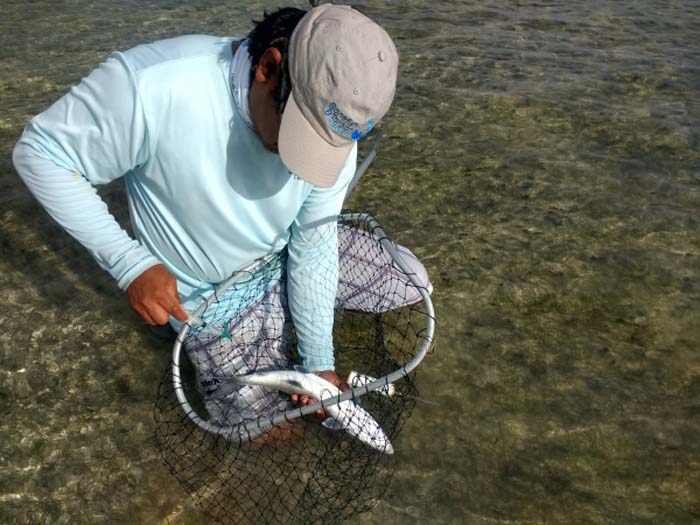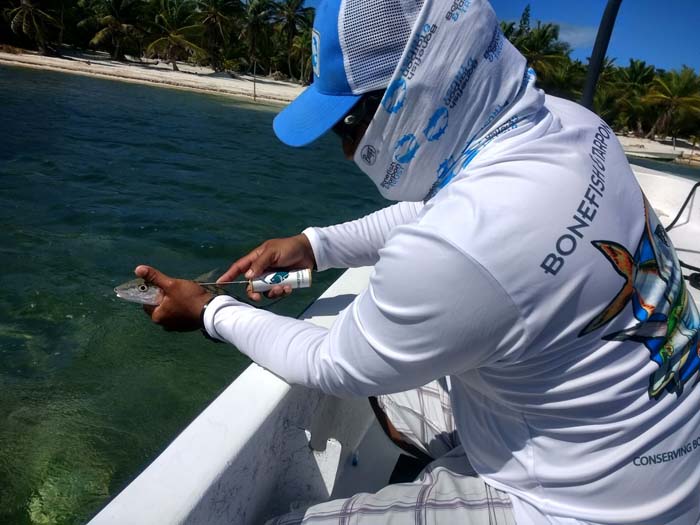Bonefish & Tarpon Trust forges ahead with egalité
Bonefish & Tarpon Trust… All in works
By Skip Clement
[dropcap]B[/dropcap]onefish & Tarpon Trust, began under the management care of Aaron Adams and a select board of serious flyfishers/conservationists with deep pockets. They captured a revolution of organizational magnitude unknown in science, and it took place on Adam’s watch. It continues on the same learned path under Jim McDuffie and the current board of directors.
That uniqueness of BTT’s Adams driven resolve was to embrace fly fishers worldwide that had a passion for the flats game, and especially take in arms the fly fishing guides of the Bahamas, Florida Keys, Belize, Mexico, Cayman Islands, Cuba of late, and beyond.

Addiel Perez tags a bonefish. Photo courtesy of Addiel Perez.
The scientists from the U. S., The Bahamas, Canada, and beyond warmed immediately to accepting individual anglers, professional guides, personal lodge owners, and government agency personnel involved in fisheries as equals
The establishment of that singular embrace, “Liberté, Egalité, Fraternité” has vaulted scientific results unmatched in closed ranks science approaches to fisheries data.
Instead of decades of incestuous research for a pinch of scientific fruit-bearing, a few years of all-in analysis has produced research papers with an astounding array of conclusions for BTT.
Results Matter
For example, BTT now knows bonefish geographic ranges, foraging routes, spawning triggers, spawning profiles, spawning destinations, habitat essentials, local diets, and so much more in the Keys and Bahamas and soon to come other coordinates.
The all-inclusive attitude of BTT science has created highly productive tagging program for bonefish, tarpon, and permit. Uniquely, participating has taken on the status of being someone of significance in local, regional and in some instances countrywide citizens.
Here’s BTT most current achievement:
Resource Managers and Stakeholders Collaborate to Conserve Bonefish in Belize
[dropcap]R[/dropcap]esearch over the past few years by BTT associate scientist Addiel Perez identified a bonefish pre-spawning site, with the spawning site likely near northern Ambergris Caye. The research shows that bonefish migrate to this pre-spawning site from throughout the region–from San Pedro and Corozal Bay in Belize, Chetumal Bay and Xcalak in Mexico, and beyond. This means that any damage to this important site or harvest of these pre-spawning fish threatens the region’s economically important bonefish fishery.

Addiel Perez tags a bonefish. Photo courtesy of Addiel Perez.
As a continuation of this work, and to take the next steps in conservation, earlier this month Perez led the first collaborative effort between stakeholders (El Pescador Lodge and Villas, Omar’s Freelance Fishing, Blue Bonefish) and resource managers (Hol Chan Marine Reserve and Belize Fisheries Department) to monitor bonefish pre-spawning activity. The goals of this collaboration are to continue the research to better understand bonefish spawning behavior, begin the process of education so that the importance of this location is known, and build a strong conservation partnership.
“The important next step is to use this new knowledge to inform stakeholders and resource managers for better decision making,” said Perez.
Javier Paredez, manager of the Hol Chan Marine Reserve, agreed. “Information generated through science is important for us as managers because it informs and enables us to make correct decisions,” he said. “We hope to continue partnering with BTT in efforts like these.”
And even though the focus of this collaboration is local, the implications are regional, since these pre-spawning and spawning sites provide new bonefish to the local populations and also the larger seascape, which includes Florida. Click here to learn more about bonefish connectivity across the Caribbean.
Join BTT and stay “Flats In the Know” worldwide . . .





